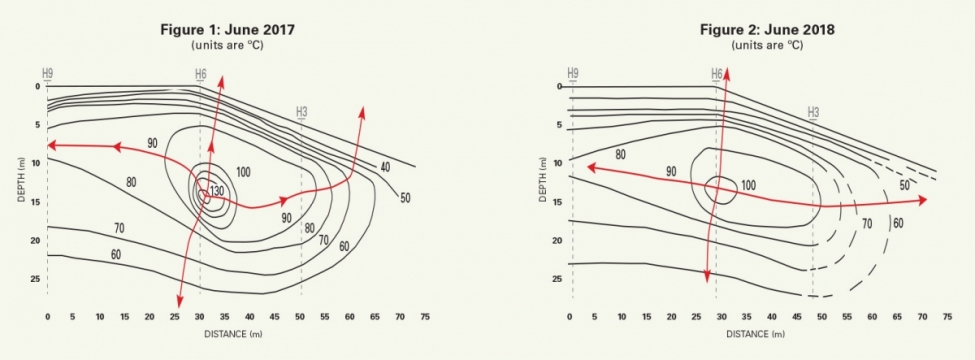To serve you better, our new website displays information specific to your location.
Please visit the site and bookmark it for future use.
You are here
SRK Kazakhstan ›Managing spontaneous combustion in coal overburden spoil piles
|
Download A4 | Letter |
SRK News | Issue 59:
Environmental & Social Services
Andrew Garvie, Principal Consultant (Geochemistry)
The Leigh Creek coal mine, located approximately 500 km north of Adelaide in South Australia, operated between 1944 and 2015. The coal at Leigh Creek mine is a low rank, sub-bituminous brown coal that is prone to self-heating and spontaneous combustion. Spontaneous combustion has occurred in the spoil piles throughout the decades of the mining operation. Consequently, the management strategies suitable for short-term control of spontaneous combustion were developed but were not specifically tailored for long-term closure.
Laboratory testing was undertaken to examine the spontaneous combustion propensity of some of the coal and overburden units mined at Leigh Creek. Tests indicated that while carbonaceous rocks retained a fuel load, in isolation, these did not have the capacity to reach thermal runaway. However, the potential existed for heat from another source, such as coal, to raise the temperature of these rocks to above the threshold for thermal runaway (>100°C).
A monitored trial of the spontaneous combustion rehabilitation strategy was included in the mine closure plan submitted to the regulator; the objective was to demonstrate the strategy’s effectiveness. The strategy included reducing batter slopes of waste spoil piles and applying an inert cover of 1.2 m thickness. The trial was established in June 2017 in a location where active combustion occurred immediately prior to rehabilitation treatment. Measurements of temperature and oxygen concentrations within the spoil pile over twelve months show that oxygen is consumed within 1 m of the outer surface of the waste, while maximum spoil pile temperatures have been decreasing, indicating a net heat loss from the trial spoil pile area (Figures 1 and 2). No spontaneous combustion outbreaks have occurred in the trial area since the trial commenced.
Samples of the small quantities of aged coal in the spoil piles had a ‘Low-Medium’ to ‘Medium’ rating of intrinsic spontaneous combustion (much lower than the equivalent fresh coal samples), and did not have sufficient reactivity to overcome the heat loss associated with moisture evaporation. Therefore, it is concluded that the coal in the spoil piles would not be likely to reach thermal runaway via self-heating. Most non-coal spoil is carbonaceous mudstone. The carbonaceous mudstone presents a fuel load, but would require a heat source, or heat from the oxidation of coal, to raise temperatures in excess of 100°C, for thermal runaway to occur.
The monitoring results indicate that the resloping and covering have been effective in limiting the oxygen supply into the spoil and have allowed temperatures in most of the underlying material to decrease, thereby reducing the likelihood of ongoing spontaneous combustion.
A more comprehensive description of the work was presented at the Coal Operators’ Conference 2019 (https://ro.uow.edu.au/coal/719/).
Andrew Garvie: agarvie@srk.com.au


